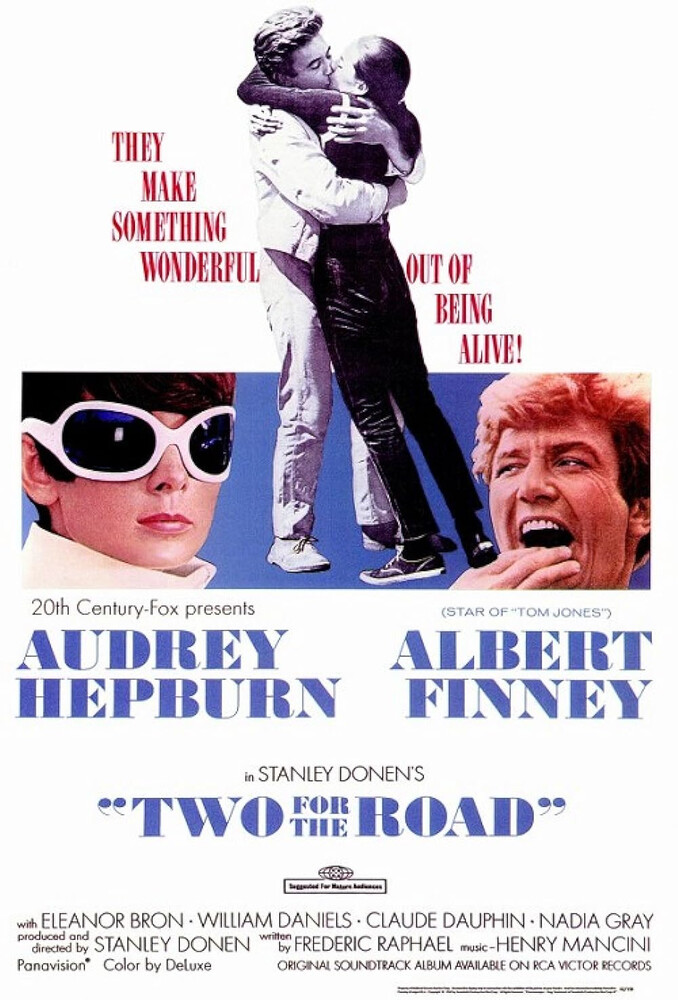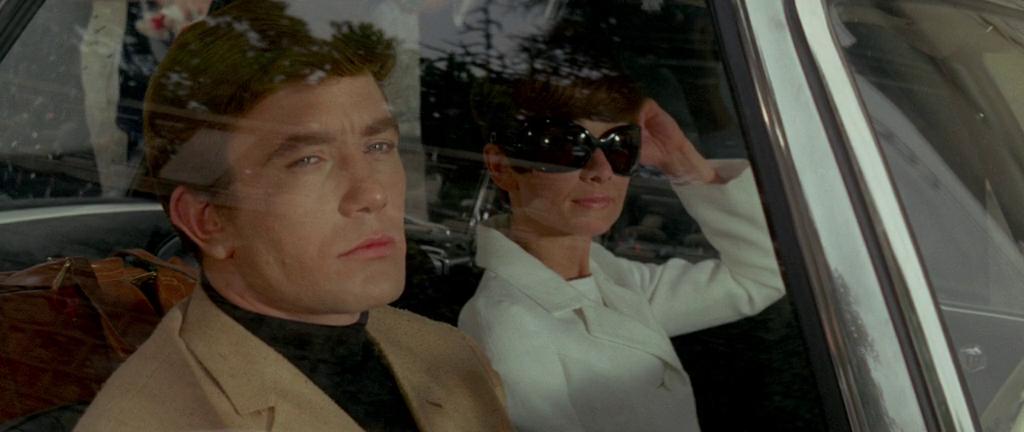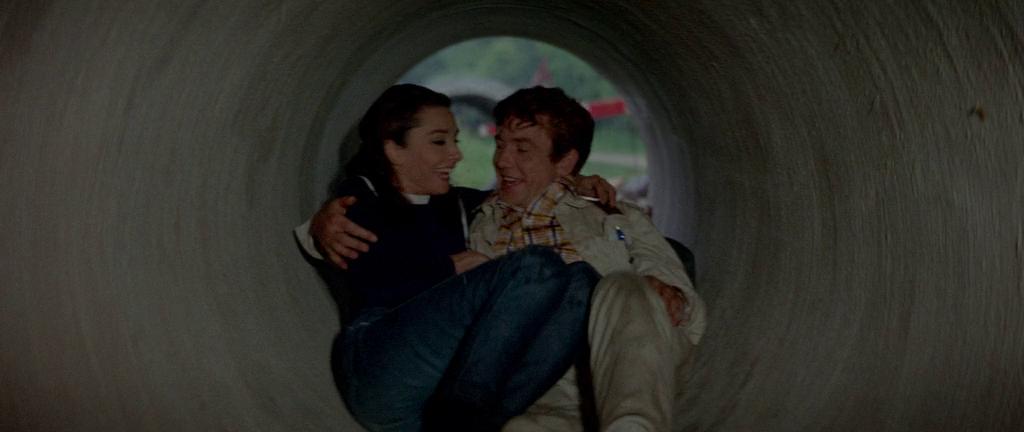Director: Stanley Donen
Writer: Frederic Raphael
Stars: Audrey Hepburn and Albert Finney
 |
I had never heard of Two for the Road before plucking it out of Stanley Donen’s filmography for this project, but I’m very happy that I did. It’s technically a British film, but the funding came from a Hollywood studio—20th Century Fox—and it was primarily shot in France, so it’s an international picture and that’s highly appropriate because it feels like an international film, a romantic comedy obviously influenced by the French New Wave. It was shot in 1966 and, while it certainly looks like it was shot in 1966, it also feels like it could have been made yesterday because it’s that timeless; and let’s be honest, how many films shot in 1966 can you say that about? It wasn’t much of a commercial success, making back $12m on a $5m budget, but it was highly regarded by the critics. More than one has described it as Donen’s best movie, even though he also directed Singin’ in the Rain; it’s often been described as having Audrey Hepburn’s greatest performance; and Henry Mancini has claimed that his theme is his personal favourite from his work.
Clearly I should take a look at it to remember Donen and his career, on what would have been his centennial; he came pretty close to celebrating it too, passing in 2019 at the age of 94. The lead actors are Hepburn and Albert Finney, the latter of which was fresh from the success of Tom Jones and the former very close to her initial retirement, with only Wait Until Dark following it until a much anticipated return a decade later in 1976’s Robin and Marian. The most important name, though, at least to this particular picture, is that of Frederic Raphael, who wrote the original screenplay. It’s not exactly autobiographical, but it was sparked by a road trip that he and his wife took through France, some of the script taken from things that they did but much of it taken from things that they didn’t do but could well have done in a parallel universe. He received an Oscar nomination for his work, the film’s only nomination as Hepburn was nominated for Wait Until Dark instead, but he lost to William Rose for Guess Who’s Coming to Dinner.
 |
The point is that they’re wondering about what went wrong, given how much had happened for them on this journey in the past. How did they become the couple they are now and is there anything in that history that can help them as a couple going forward? More importantly, given that this appears to be about a breakdown in a marriage, is it going to actually be enjoyable for us or just an opportunity for the actors? I’m not going to answer all those questions now, because it’s such an impressive film that you ought to see it for yourself, but I will answer the last one: yes, it’s an enjoyable film for us to watch, maybe not every moment because it’s certainly not all sunshine and unicorns, but it’s real and it’s honest and it’s often highly affirming. It’s not only the moments when Mark and Joanna are blissfully happy, either; some of the best moments for me are when they aren’t, because they’re dealing with some sort of calamity, but do so emphatically in accord and that, in a film that questions what marriage is, is what marriage is.
 |
The earliest of the trips takes place in 1954—so says Wikipedia—when Mark and Joanna meet for the first time. He’s travelling solo, an architectural student visiting the continent to take photos, while she’s part of a choir of young ladies on their way to a festival, presumably to perform. Neither of them accomplish what they had in mind, because they end up travelling together and falling in love. It’s notable that while they do lock eyes on the ferry over and Joanna finds his passport for him at a crucial moment, starting that long running tradition, he’s actually more interested in one of her colleagues. In fact, after he jumps off the back of the tractor he’s hitching to help them when their Volkswagen minibus runs off the road, and so joins their party, it’s Jackie that he has his eye on, unsurprisingly given that she’s played by a young Jacqueline Bisset in her first role of any substance. It appears that the stars have aligned for him when the rest of the choir progressively go down with chicken pox, so he and Jackie can hitch on alone.
Of course, he soon learns that Joanna is fine too, because she had chicken pox as a child, and Jackie catches it after all, so destiny is enforcing itself and, while he isn’t particularly happy about it at the beginning of their time together, he certainly is by the time a week ends and he, so vocal about his disdain for the institution of marriage, proposes to her. Church bells were ringing at the very start of the picture, as Mark and Joanna are temporarily blocked on their way to the airport by a wedding party. “They don’t look very happy”, suggests Joanna. “Why should they?” replies Mark. “They just got married.” On that first trip, he tells her that he has no intention of getting married for at least forty years. Women just put you in a pigeonhole, he says. They want your head stuffed and mounted on the living room wall. Meanwhile, he’s already become utterly reliant on her, because she effortlessly does all the things that he needs to do but doesn’t, including remembering his passport yet again after he leaves it behind.
 |
The script is blisteringly good here, constantly setting up contrasts. The dialogue has been impeccable since the outset, but every cut here seems to arrive with bookends. Someone will say something, and the scene will give way to another that proves the exact opposite. My favourite is the one that takes us from the 1954 trip to the 1957 trip. In 1954, Mark tells Joanna about his girlfriend in Chicago, when he was studying architecture there, Cathy Seligman. “Lucky for you, you’ll never have to meet her,” he explains. In 1957, they’re sitting in the back of a car with Cathy and her husband, Howard Maxwell-Manchester, in the front. The next line is “I always knew you two had to meet.” It’s this trip that’s both my favourite and my least favourite. It’s my least favourite because it’s hard to imagine having to spend any time with the constantly annoying Maxwell-Manchesters and their spoiled brat of a daughter, Ruthie. It’s my favourite because the Wallaces do so and suffering quietly together proves how good they are as a couple.
I’m not going to talk as much about the later trips, because that would take me into spoiler territory, but the third is in 1959 when the Wallaces travel together for the first time and experience most of the two elements that go into romantic comedy. Things go horribly wrong for them but things also go wonderfully right and, if that isn’t a metaphor for their marriage, I don’t know what is. There’s a solo trip for Mark in 1961, which nonetheless has meaning for them both, and then there’s a trip together in 1963, with a daughter, Caroline, along for the ride. If 1959 was the high for them, then 1963 is the low, which leaves us to wonder how 1966, the present day trip, will factor into that ranking. And, while the script doesn’t really tell us, because Raphael wants us to figure that out for ourselves, it does cleverly give us enough clues to do so. Of course, this is fundamentally about a relationship and, if I have learned anything about them in my twenty years of marriage, it’s that there are always two ways to look at anything.
 |
I liked this a lot and I’m not typically a fan of romantic comedies, just like I’m not typically a fan of musicals, one of Donen’s go to genres, and yet I’d suggest that his Singin’ in the Rain may well be the greatest one ever made. Much of the joy is in the script, the first half hour being textbook perfect in its use of dialogue, especially spanning the cuts between scenes. However, there are also joyous performances. Hepburn is one of the easiest actresses for any moviegoer to fall in love with, but, when she’s happy in this film, she’s utterly magnetic. Finney is very dry, perhaps a little too dry at times, but he has a wickedness behind the dryness and there’s clear charisma between them. Hepburn was married to Jose Ferrer at the time but the marriage was failing, aided by her miscarriage in 1966 early into a pregnancy. It seems that Finney was the perfect medicine for her and how well they hit it off had an admirable impact on her performance, easily one of the most complex and accomplished of her career.
I keep coming back to how timeless the film feels to me. There are ways in which it’s very much of its time, because we see plenty of things that we wouldn’t dream of seeing today. Joanna happily smokes on the ferry plane to France. She shares a joint passport with her husband as Mr. & Mrs. Wallace. Never mind no seatbelts, Ruthie plays in the floorboards in front of her mother inside the passenger seat of their car. She also goes potty what seems like everywhere, not only at the side of a public road but also right in front of tourist attractions. It was certainly a different time, but that doesn’t mean that the film feels like it was made when those things were seen as norms, just as we don’t watch period dramas and expect them to have been made in 1786. The main reason it feels like a 1967 movie is because it stars Audrey Hepburn in her late thirties—shooting began the day before her 37th birthday—and she’s a cinematic icon whom even people who aren’t classic film buffs can recognise, even in more contemporary clothing.
 |
However, I’m watching this for Stanley Donen, the director of Two for the Road, who would have been a hundred years old today, an immensely important name in Hollywood who made films that I adore and films that I loathe. Many classic film fans might say the same thing, but with different choices as to which in both categories, and that’s the sort of thing that means an artist. He was given an Honorary Academy Award in 1998 for his career, which was almost over, only a TV movie left, coincidentally another film that’s almost entirely told in flashbacks, 1999’s Love Letters. Otherwise, he mostly retired after a set of unusual credits in 1986. He directed the musical number in an episode of Moonlighting called Big Man on Mulberry Street and the music video for Lionel Richie’s Dancing on the Ceiling, which used the same techniques that he’d previously employed for the You’re All the World to Me number in Royal Wedding back in 1951. He also produced the TV broadcast of the Oscar ceremony, though he shockingly never won a competitive Oscar.
That’s a lot for someone who started his career as a chorus line dancer on Broadway. He was born in Columbia, South Carolina to a Jewish family, which prompted isolation and antisemitism, so he found an escape in movie theatres. He made films himself with an 8mm camera and found enough inspiration from Fred Astaire’s performance in Flying Down to Rio to take dance lessons. It paid off, a mere third audition on Broadway in 1940 landing him a spot in the chorus line in Pal Joey, with Gene Kelly in the lead. He moved up to assistant stage manager and Kelly’s assistant choreographer on his next job, Best Foot Forward, and it was after Arthur Freed, the musicals producer at MGM, bought the film rights to Best Foot Forward that Donen moved to Hollywood to audition. He landed a one year contract and appeared in the chorus but, more importantly, rekindled his acquaintance with Kelly, who was doing supporting roles in movies by then. It was Kelly who brought him in to help choreograph three numbers in Cover Girl and the rest is history.
 |
Hilariously, director Charles Vidor was so convinced that an idea that Kelly and Donen had for one of those numbers couldn’t work that the two upstarts directed it themselves. It’s the scene where Kelly’s reflection jumps out of a shop window to dance with him, known as the “Alter Ego” sequence, and it made Kelly a star and Donen an innovative success. Of course, that meant a career and a number of films for Columbia and MGM. The two were inseparable as creative partners, landing credits together on nine pictures, though four of those were for other directors, Donen’s contributions being as a choreographer and, on Take Me Out to the Ball Game, co-writer of the story. That work was important, especially on Anchors Aweigh, when Donen choreographed the pioneering number when Kelly danced with Jerry, the mouse from Tom and Jerry. They shared directorial credits on On the Town, Singin’ in the Rain and It’s Always Fair Weather, while Kelly appeared in two other films Donen directed, Love is Better Than Ever and Deep in My Heart.
As you can imagine, Donen was mostly known as a director of musicals at this point, On the Town being his debut and other pictures without Kelly including Royal Wedding with his inspiration Fred Astaire; Seven Brides for Seven Brothers; and Funny Face, a film I loathe for its embrace of surface, with Audrey Hepburn and Astaire again. He made films in other genres too, but they tended to be light-hearted comedies, such as Fearless Fagan with Janet Leigh and a lion; The Pajama Game with Doris Day; and Indiscreet with Cary Grant. The latter was his first film as an independent producer and, after it, he moved to England and often shot movies on the continent: Once More, with Feeling! in France, Surprise Package in Greece and Charade in France again. In many ways that set the stage for Two for the Road, being a romantic comedy set in France with Audrey Hepburn in the lead and with music by Henry Mancini, but it added a mystery element that this film avoids, leading to it being described as “the best Hitchcock movie Hitchcock never made”.
 |
Two for the Road arrived after another Hitchcock-style picture, Arabesque, starring Gregory Peck and Sophia Loren, for arguably his best three films in a row. However, as the sixties moved towards and into the seventies, he took surprising directions and, though each of his films from this area has its fans, often disappointed his own and struggled at the box office. Next up was Bedazzled, the swinging sixties comedy take on Faust with British comedians Peter Cook and Dudley Moore, along with Raquel Welch as Lust. At least that was a commercial success, especially at the British box office, but Staircase wasn’t and neither was The Little Prince, which he made for Hollywood and back in musicals. Lucky Lady failed and so did Movie Movie, a faux double feature presented by George Burns, and Saturn 3, a surprising science fiction film for Donen, did as well, even landing a trio of Razzie Award nominations. No wonder he retired after Blame It on Rio, a remake of a French film, which failed critically but did make some money.
No wonder, also, that he’s primarily remembered for his work with Gene Kelly and, to a lesser degree, his later work with Audrey Hepburn. The history books will concentrate mostly on how he and Kelly brought the musical into a new age, inventing what has been termed “cine-dance”, in which the arts of dancing and filmmaking were brought together as a new art. While Donen’s career was sparked by Flying Down to Rio, he has said that he didn’t like the backstage musicals of the thirties which revolved around a cast and crew putting on a show, and made his films with Kelly in deliberate opposition to that. He credits Arthur Freed as the man who instinctively felt the need for musicals to change but suggests that he didn’t know how to do it, just that it needed to be done. Kelly and Donen did it. Not being a particular fan of musicals, I tend to prefer the cinematic surrealism of Busby Berkeley, who certainly made backstage musicals, but I can’t fail to acknowledge the importance of what Donen and Kelly did to move the genre forward.
 |
Sadly, the two fell out, perhaps mostly due to disagreements over how to divvy up the credit that was surely owed to both of them. That’s been perpetuated by biographers, but it goes back to their time actually working together. They fought, ironically given the title of the movie, on the set of It’s Always Fair Weather and their friendship ended because of that. Donen swore never to make any further films with Kelly and he lived up to that promise. I don’t know if this has any relevance to that, but off screen, Donen had a Hollywood number of relationships, marrying and divorcing five different women, including dancer Jeanne Coyne, actress Marion Marshall and actress Yvette Mimieux. He also dated Judy Holliday and Elizabeth Taylor and claims to have proposed to Elaine May, a fellow director and late life companion, “about 172 times”. All three of his children have worked in the industry: Peter as a visual effects artist, Joshua as a producer and Mark as a production assistant. Stanley Donen died in 2019 at the age of 94.



No comments:
Post a Comment